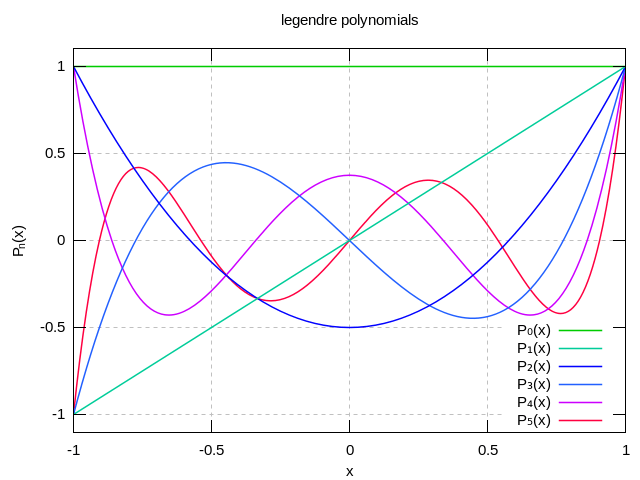Legendre polynomials
In mathematics, Legendre functions are solutions to Legendre's differential equation:
-
(1)
They are named after Adrien-Marie Legendre. This ordinary differential equation is frequently encountered in physics and other technical fields. In particular, it occurs when solving Laplace's equation (and related partial differential equations) in spherical coordinates.
The Legendre differential equation may be solved using the standard power series method. The equation has regular singular points at x = ±1 so, in general, a series solution about the origin will only converge for |x| < 1. When n is an integer, the solution Pn(x) that is regular at x = 1 is also regular at x = −1, and the series for this solution terminates (i.e. it is a polynomial).
These solutions for n = 0, 1, 2, ... (with the normalization Pn(1) = 1) form a polynomial sequence of orthogonal polynomials called the Legendre polynomials. Each Legendre polynomial Pn(x) is an nth-degree polynomial. It may be expressed using Rodrigues' formula:
That these polynomials satisfy the Legendre differential equation (1) follows by differentiating n + 1 times both sides of the identity
and employing the general Leibniz rule for repeated differentiation.[1] The Pn can also be defined as the coefficients in a Taylor series expansion:[2]
-
(2)
In physics, this ordinary generating function is the basis for multipole expansions.
Recursive definition
Expanding the Taylor series in Equation (2) for the first two terms gives
for the first two Legendre Polynomials. To obtain further terms without resorting to direct expansion of the Taylor series, equation (2) is differentiated with respect to t on both sides and rearranged to obtain
Replacing the quotient of the square root with its definition in (2), and equating the coefficients of powers of t in the resulting expansion gives Bonnet’s recursion formula
This relation, along with the first two polynomials P0 and P1, allows the Legendre Polynomials to be generated recursively.
Explicit representations include
where the latter, which is immediate from the recursion formula, expresses the Legendre polynomials by simple monomials and involves the multiplicative formula of the binomial coefficient.
The first few Legendre polynomials are:
The graphs of these polynomials (up to n = 5) are shown below:

Orthogonality
An important property of the Legendre polynomials is that they are orthogonal with respect to the L2-norm on the interval −1 ≤ x ≤ 1:
(where δmn denotes the Kronecker delta, equal to 1 if m = n and to 0 otherwise). In fact, an alternative derivation of the Legendre polynomials is by carrying out the Gram–Schmidt process on the polynomials {1, x, x2, ...} with respect to this inner product. The reason for this orthogonality property is that the Legendre differential equation can be viewed as a Sturm–Liouville problem, where the Legendre polynomials are eigenfunctions of a Hermitian differential operator:
where the eigenvalue λ corresponds to n(n + 1).
Applications of Legendre polynomials in physics
The Legendre polynomials were first introduced in 1782 by Adrien-Marie Legendre[3] as the coefficients in the expansion of the Newtonian potential
where and are the lengths of the vectors and respectively and is the angle between those two vectors. The series converges when . The expression gives the gravitational potential associated to a point mass or the Coulomb potential associated to a point charge. The expansion using Legendre polynomials might be useful, for instance, when integrating this expression over a continuous mass or charge distribution.
Legendre polynomials occur in the solution of Laplace's equation of the static potential, , in a charge-free region of space, using the method of separation of variables, where the boundary conditions have axial symmetry (no dependence on an azimuthal angle). Where is the axis of symmetry and is the angle between the position of the observer and the axis (the zenith angle), the solution for the potential will be
and are to be determined according to the boundary condition of each problem.[4]
They also appear when solving Schrödinger equation in three dimensions for a central force.
Legendre polynomials in multipole expansions

Legendre polynomials are also useful in expanding functions of the form (this is the same as before, written a little differently):
which arise naturally in multipole expansions. The left-hand side of the equation is the generating function for the Legendre polynomials.
As an example, the electric potential (in spherical coordinates) due to a point charge located on the z-axis at (Figure 2) varies like
If the radius r of the observation point P is greater than a, the potential may be expanded in the Legendre polynomials
where we have defined η = a/r < 1 and x = cos θ. This expansion is used to develop the normal multipole expansion.
Conversely, if the radius r of the observation point P is smaller than a, the potential may still be expanded in the Legendre polynomials as above, but with a and r exchanged. This expansion is the basis of interior multipole expansion.
Legendre polynomials in trigonometry
The trigonometric functions , also denoted as the Chebyshev polynomials , can also be multipole expanded by the Legendre polynomials . The first several orders are as follows:
Another property is the expression for , which is
Additional properties of Legendre polynomials
Legendre polynomials are symmetric or antisymmetric, that is
Since the differential equation and the orthogonality property are independent of scaling, the Legendre polynomials' definitions are "standardized" (sometimes called "normalization", but note that the actual norm is not unity) by being scaled so that
The derivative at the end point is given by
As discussed above, the Legendre polynomials obey the three term recurrence relation known as Bonnet’s recursion formula
and
Useful for the integration of Legendre polynomials is
From the above one can see also that
or equivalently
where is the norm over the interval −1 ≤ x ≤ 1
From Bonnet’s recursion formula one obtains by induction the explicit representation
The Askey–Gasper inequality for Legendre polynomials reads
A sum of Legendre polynomials is related to the Dirac delta function for and
The Legendre polynomials of a scalar product of unit vectors can be expanded with spherical harmonics using
where the unit vectors r and r' have spherical coordinates and , respectively.
Asymptotically for for arguments less than unity
and for arguments greater than unity
where and are Bessel functions.
Shifted Legendre polynomials
The shifted Legendre polynomials are defined as . Here the "shifting" function (in fact, it is an affine transformation) is chosen such that it bijectively maps the interval [0, 1] to the interval [−1, 1], implying that the polynomials are orthogonal on [0, 1]:
An explicit expression for the shifted Legendre polynomials is given by
The analogue of Rodrigues' formula for the shifted Legendre polynomials is
The first few shifted Legendre polynomials are:
Legendre functions of the second kind
As well as polynomial solutions, the Legendre equation has non-polynomial solutions represented by infinite series. These are the Legendre functions of the second kind, denoted by .
The differential equation
has the general solution
- ,
where A and B are constants.
Legendre functions of fractional degree
Legendre functions of fractional degree exist and follow from insertion of fractional derivatives as defined by fractional calculus and non-integer factorials (defined by the gamma function) into the Rodrigues' formula. The resulting functions continue to satisfy the Legendre differential equation throughout (−1,1), but are no longer regular at the endpoints. The fractional degree Legendre function Pn agrees with the associated Legendre polynomial P0
n.
See also
- Associated Legendre polynomials
- Gaussian quadrature
- Gegenbauer polynomials
- Legendre rational functions
- Turán's inequalities
- Legendre wavelet
- Jacobi polynomials
- Romanovski polynomials
- Spherical Harmonics
Notes
- ↑ Courant & Hilbert 1953, II, §8
- ↑ Arfken & Weber 2005, p.743
- ↑ M. Le Gendre, "Recherches sur l'attraction des sphéroïdes homogènes," Mémoires de Mathématiques et de Physique, présentés à l'Académie Royale des Sciences, par divers savans, et lus dans ses Assemblées, Tome X, pp. 411–435 (Paris, 1785). [Note: Legendre submitted his findings to the Academy in 1782, but they were published in 1785.] Available on-line (in French) at: http://edocs.ub.uni-frankfurt.de/volltexte/2007/3757/pdf/A009566090.pdf .
- ↑ Jackson, J.D. Classical Electrodynamics, 3rd edition, Wiley & Sons, 1999. page 103
- ↑ Arfken & Weber 2005, p.753
References
- Abramowitz, Milton; Stegun, Irene Ann, eds. (1983) [June 1964]. "Chapter 8". Handbook of Mathematical Functions with Formulas, Graphs, and Mathematical Tables. Applied Mathematics Series. 55 (Ninth reprint with additional corrections of tenth original printing with corrections (December 1972); first ed.). Washington D.C., USA; New York, USA: United States Department of Commerce, National Bureau of Standards; Dover Publications. pp. 332, 773. ISBN 0-486-61272-4. LCCN 64-60036. MR 0167642. ISBN 978-0-486-61272-0. LCCN 65-12253. See also chapter 22.
- Arfken, George B.; Weber, Hans J. (2005), Mathematical Methods for Physicists, Elsevier Academic Press, ISBN 0-12-059876-0.
- Bayin, S.S. (2006), Mathematical Methods in Science and Engineering, Wiley, Chapter 2.
- Belousov, S. L. (1962), Tables of normalized associated Legendre polynomials, Mathematical tables, 18, Pergamon Press.
- Courant, Richard; Hilbert, David (1953), Methods of Mathematical Physics, Volume 1, New York: Interscience Publischer, Inc.
- Dunster, T. M. (2010), "Legendre and Related Functions", in Olver, Frank W. J.; Lozier, Daniel M.; Boisvert, Ronald F.; Clark, Charles W., NIST Handbook of Mathematical Functions, Cambridge University Press, ISBN 978-0521192255, MR 2723248
- Koornwinder, Tom H.; Wong, Roderick S. C.; Koekoek, Roelof; Swarttouw, René F. (2010), "Orthogonal Polynomials", in Olver, Frank W. J.; Lozier, Daniel M.; Boisvert, Ronald F.; Clark, Charles W., NIST Handbook of Mathematical Functions, Cambridge University Press, ISBN 978-0521192255, MR 2723248
- Refaat El Attar (2009), Legendre Polynomials and Functions, CreateSpace, ISBN 978-1-4414-9012-4
External links
| Wikimedia Commons has media related to Legendre polynomials. |
- A quick informal derivation of the Legendre polynomial in the context of the quantum mechanics of hydrogen
- Hazewinkel, Michiel, ed. (2001), "Legendre polynomials", Encyclopedia of Mathematics, Springer, ISBN 978-1-55608-010-4
- Wolfram MathWorld entry on Legendre polynomials
- Module for Legendre Polynomials by John H. Mathews
- Dr James B. Calvert's article on Legendre polynomials from his personal collection of mathematics
- The Legendre Polynomials by Carlyle E. Moore
- Legendre Polynomials from Hyperphysics